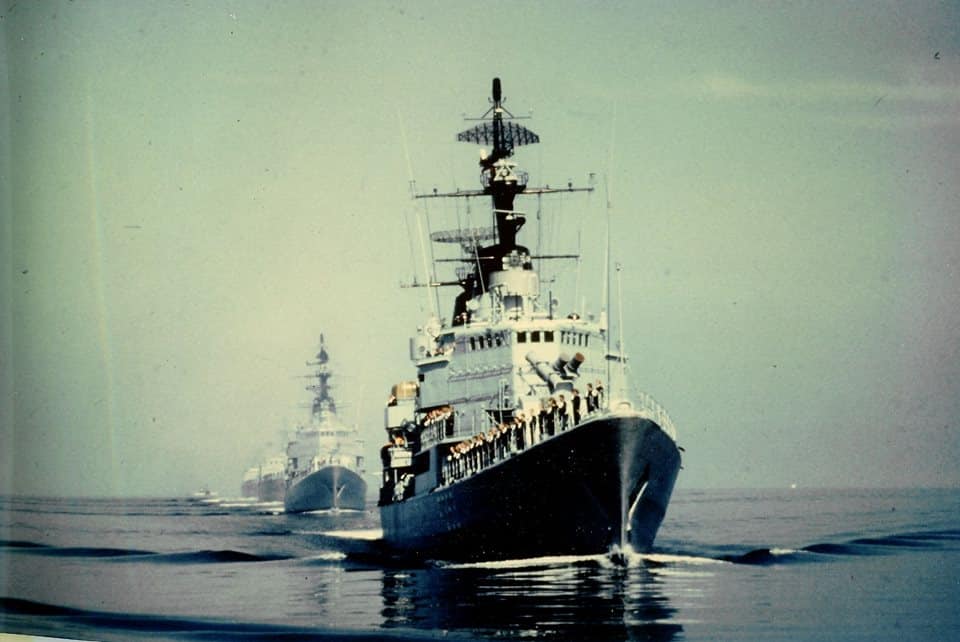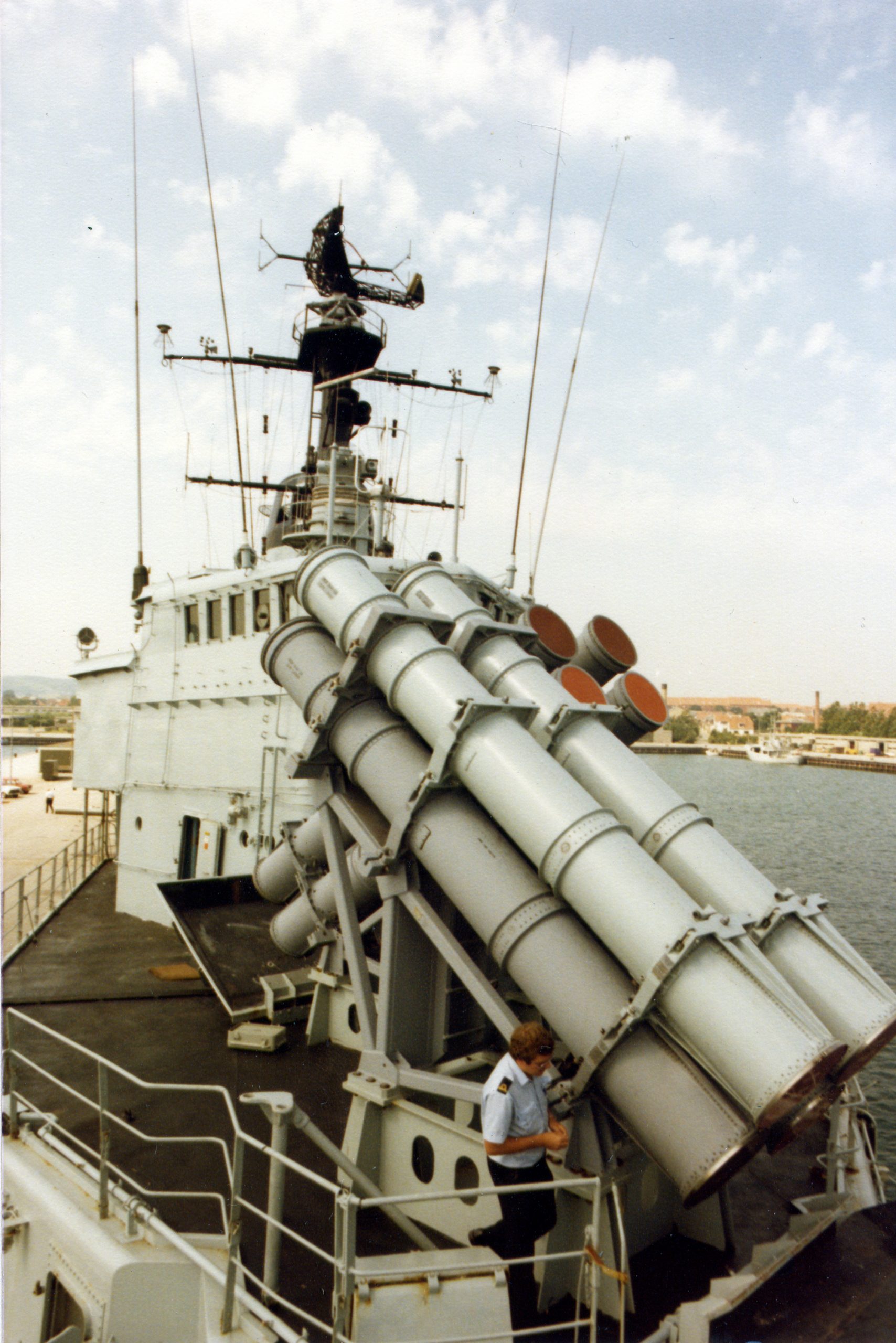

During the cold war, the frigates Peder Skram and the sistership Herluf Trolle were the ships in command in the Danish navy.
Because of this the Danish and German navy were able to conduct and participate in the invasion defence, of the defense of Denmark and Germany.
Visit the frigate PEDER SKRAM. A virtuel trip

PEDER SKRAM was equipped for the task with canons, missiles and torpedoes.
Beside the frigates were fast good maneuvering due to their machinery as they were the first battle ships with a combination of gas turbines and diesel engine and possibilities to turn the screw propellers to adjust the speed of the ship.
In 1982 PEDER SKRAM became world famous in Denmark, when a Harpoon missile by a mistake was launched from the frigate. The missile exploded in a summerhouse residence in Lumsås at Sjællands Odde.
Den 6th of September 1982 the officerer Henning G. Olsen from Søværnets Materialkommando executed a routine control of firing a missile from the HARPOON-system.
An unintended consequence did a launch of a Harpoon anti ship missile at 11.22 am from Peder Skram in the southern part of Kattegat. In a height of 5 m from sea level the missile flew 34 km on the course of 123, before it at 11.32 am detonated in a couple of trees in a summerhouse area at Lumsås at Sjællands Odde. At the explosion 4 summerhouses were damaged more or less.
No one was hurt.
A new commision investigation of 9th of July 1984 found no reasons for proseccutions.
Henning G. Olsen got a mild sentence by the court, and the expences for the damages was paid by the American manufacturer of the Harpoon missile system.

The crew
The crew was combined with officers, petty officers privates and privates first class.
From 1966 to 1977 there were 202 crew members.
After arming the ship and shifting to computer bases ploter systems,the crew could now be reduced to 172 members by 22 officers, 20 petty officers and 130 privates.
When increasing the defense preparedness the crew was extended with further more 4 officers, and 15 private first class.
Officers and petty officers lived in single or double bed cabins with shared toilets and baths. PRivate members lived at 4 orlop decks.

Numbers as id for crew members
Eah private crew member had a unique number as an id. The privates were divided into 2 shifts, called the King's- and the the Queen's shift.
The Kings shift was privates with even numbers, and the Queens shift was privates with odd numbers. The number indicated where the private was assigned during the different assignments to be solved when in battle, damages of the ship and harbour maneuverings.
Beside that the crew was divided into 4 divisions.
Operations-, weapons -, technic - and administer division
- The operation division was responsible for tacticals and communications tasks.
- The weapon division was responsible for the frigates weapon systems and their maintenances.
- The technic division was responsible for the ships diesel and turbine systems, the power generators and electrical systems.
- The administer division was responsible for the administration of the ship including salary system, food provisioning and lodning accommodation of the crew.
The captain and his second in command together with the chiefs of the 4 divisions, was the management of the ship.
They were the only ones at the ship with their own cabin. The other officers and petty officers were in a 2 person cabins.
Privates of the crew lived in orlop decks. here they slept in berths in 3 rows a top.
The officers had their meals in the officers mess, petty officers in the petty officers mess and the crew had their meals in the cafeteria.

As a part of a political arrangement in 1984, it was decided that the frigates Peder Skram and Herluf Trolle was to be phased out in 1988
In the invasion defense the tasks of the frigates were replaced by mobiel defense missile systems mounted on trucks, followed up by smaller units called the Standard flex class.
The 4th of January the command signs for the two frigates was cancelledd. A political agreement from the 8th of March 1988 was the end of the era of the Dansih frigates in the Danish Navy.
At that time nobody could hardly know that 25 years later the Navy woiuld have 3 large newbuilt frigates, each the double of Peder Skram in size.
The ship was sold on an auction in 1992 and after that delivered to the foundation of Peder Skram.
The ship today is just a look a like of the shp it was when it was closed down in 1988.
The UPS - missile 6. september 1982
In 1982 PEDER SKRAM became world famous in Denmark, when a Harpoon missile
by a mistake was launched from the frigate. The missile exploded in a
summerhouse residence in Lumsås at Sjællands Odde.
Den 6th of September 1982 the officerer Henning G. Olsen from Søværnets
Materialkommando executed a routine control of firing a missile from the
HARPOON-system.
An unintended consequence did a launch of a Harpoon anti ship missile at
11.22 o'clock from Peder Skram in the southern part of Kattegat. in a height of
5 m from sea level the missile flew 34 km on the course of 123, before it at
11.32 o'clock detonated in a couple of trees in a summerhouse area at Lumsås at
Sjællands Odde.
At the explosion 4 summerhouses were damaged. more or less.
No one was hurt.
A new commision investigation of 9th of July 1984 found no reasons for
proseccutions.
Henning G. Olsen got a mild sentence by the court, and the expences for the damages was
paid by the american manufacturer of the Harpoon missile system.

Henning G. Olsen

The first Harpoon missile launched from the sistership Herluf Trolle the 2nd of December 1977

Peder Skram Harpoon after "UPS" 1982

The Harpoon deck on Peder Skram.

The first signal sent from Peder Skram after "UPS" missile launch in 1982.

Photo of one of the damaged summerhouses, destroyed by the missile.

The missile flew in a height of 5 meter above sea level in a distance of 34 kilometers on a course of 123 degrees, before it 11:32 AM detonated in some trees in a summerhouse area in Lumsås, Sjællands Odde.

BT 31st of August 1983. Theese articles are from the Danish daily news papers.

Many did not agree that it was H.G. Olsens fault.

After the frigates stopped sailing in the Danish Navy, people ment it was safe againg, t buy summerhouses at Lumsås Sjællands Odde.
